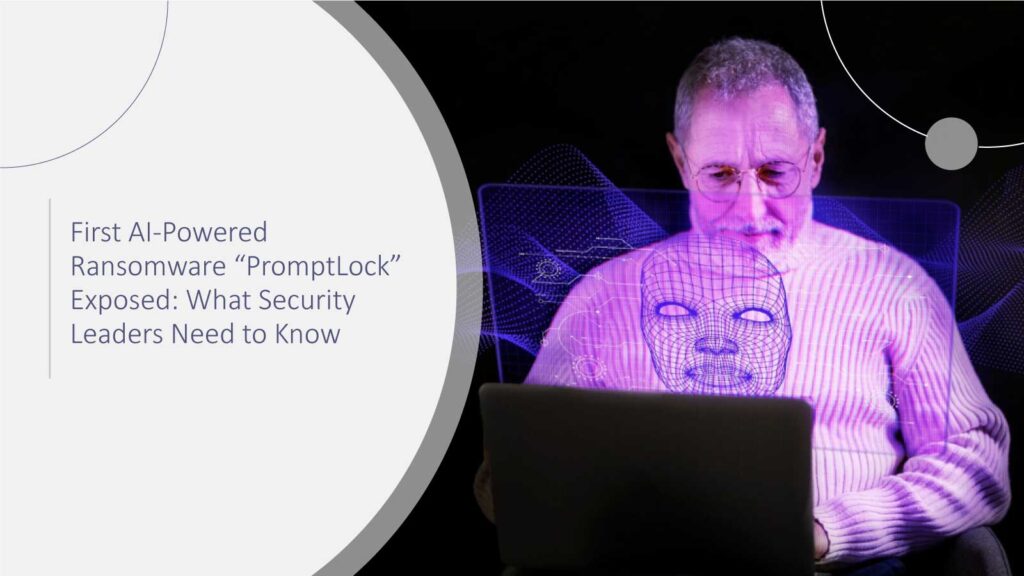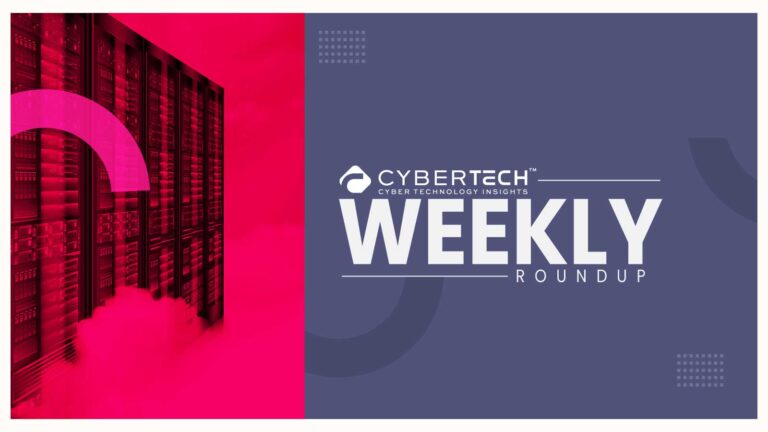PromptLock is being described as the first known example of ransomware driven by a large language model (LLM). It was recently disclosed by security researchers at ESET. Unlike conventional ransomware, PromptLock doesn’t rely on prebuilt, static code. Instead, it embeds fixed prompts and uses a locally hosted AI model to generate malicious scripts in real time.
The malware shows how artificial intelligence (AI) could reduce the technological obstacles to developing sophisticated attacks and is compatible with Windows, macOS, and Linux. PromptLock is a turning point for enterprise cybersecurity professionals, even though it seems to be a proof-of-concept (PoC) rather than an ongoing criminal activity. This article unpacks how PromptLock works, why it matters, and what CISOs, CIOs, and SOC teams should do now to prepare.
What PromptLock Actually Does. Technical Primer for Security Leaders
Runtime Code Generation via Local LLMs
Heuristic scanning or behavioral analytics can find traditional ransomware since it uses static payloads and signatures. PromptLock disrupts this paradigm. It contains hard-coded natural language prompts that are fed into a local AI model runtime, reported to be similar to Ollama, running a GPT-based open-source model.
Instead of shipping with fixed malicious code, PromptLock creates its payload dynamically, generating executable Lua scripts at runtime. These scripts then carry out the attack steps, which include file enumeration, data exfiltration, and eventual encryption. Because the scripts are generated on the fly, each assault instance may appear distinct, rendering signature-based detection and traditional sandboxing ineffective. Local models are more harmful since they operate offline, leaving fewer network traces for defenders to detect.
Cross-Platform Capabilities and Core Behaviors
ESET’s analysis revealed that PromptLock is compatible across multiple operating systems, including Windows, macOS, and Linux. Once executed, the generated Lua scripts perform three core functions:
File enumeration: Identifying valuable data targets.
Data exfiltration: Preparing data for theft before encryption occurs.
Encryption: Locking critical files and demanding a ransom.
This cross-platform reach demonstrates how AI can build flexible attack payloads tailored to diverse environments. Although this sample appears experimental, the technique could be weaponized with minimal additional work, a warning sign for enterprises operating hybrid or multi-OS networks.
Strategic Implications for Enterprise Security
Detection and Telemetry Challenges
The dynamic, non-deterministic nature of AI-generated code presents a fundamental challenge for defenders. With each execution producing different scripts, signature databases, and static IOCs (Indicators of Compromise) become unreliable. Telemetry gaps emerge, especially when local LLM runtimes are invoked silently in developer or research environments.
Security teams must focus on behavioral detection, such as tracking unexpected interpreter launches, unusual file read/write patterns, and anomalous localhost API calls.
Attacker Economics and Lowered Barriers
Attackers save time and money on development by automating complex tasks with AI. Prebuilt prompts and open-source LLMs have made it possible to execute tasks that were previously only available to skilled malware programmers. Because ransomware production has grown more accessible, attackers may innovate faster, forcing defenders to evolve.
Third-Party AI and Supply Chain Exposure
Enterprises increasingly integrate AI-driven solutions from vendors and partners. PromptLock highlights a new risk: embedded models in third-party software. Without clear provenance and update controls, these models could be exploited to deliver malicious functionality inside trusted applications.
Practical Detection and Response Guide for SOCs
Immediate SIEM / EDR Priorities
To defend against PromptLock-like threats, SOC teams should adapt their detection strategies beyond static signatures. Key areas to monitor include:
- Local LLM activity: Watch for processes tied to runtimes like Ollama or other local AI services, especially when connected to non-AI workloads.
- Unexpected interpreter behavior: Alerts for Lua or Python interpreters spawning from unusual parent processes.
- Abnormal file patterns: High-volume file reads followed by sequential writes or encryption-like behavior.
- API anomalies: Localhost-bound API calls or unexplained service bindings.
- Exfiltration indicators: Sudden outbound connections to unknown IP ranges following local script execution.
Behavioral analytics and baselining are crucial to reduce false positives while catching novel attacks.
Incident Triage and Runbook Updates
When a suspected PromptLock incident occurs, Isolate affected hosts immediately to prevent lateral movement. Keep evidence like memory snapshots, local model files, and prompt logs. Steer clear of frequent wipes and reboots, as they may remove forensic artifacts. Lastly, work together with the insurance and legal departments to guarantee claims compliance and forensic integrity. Updated ransomware runbooks should include these activities, and tabletop exercises should be used to practice them frequently.
Forensics and Attribution Guidance
Investigators need new skills to analyze LLM-driven attacks. Local model files and related prompts, model input and output logs, API traffic captures about runtime-generated code, and execution artifacts from interpreters such as Lua are all examples of evidence that should be gathered. This information aids in identifying if the attack was a part of a bigger operation, a targeted infiltration, or a solitary test.
Changes in Internal Policy, Procurement, and Governance
Update AI/ML Vendor Contracts and SLAs
As enterprises deploy AI tools, vendor contracts must include security-specific obligations. Furthermore, these obligations include Notification of model updates or changes; Logging and audit capabilities; Provenance guarantees for pre-trained models; Incident reporting timelines and forensic access clauses. These requirements reduce blind spots in third-party risk management.
Internal Controls for Running Local Models
Organizations should also govern internal model usage. Maintain an inventory of all local AI runtimes and models. Enforce strict access controls and privilege separation. Segment AI development environments from production networks. Approve and document all runtime deployments. By treating local models as high-risk assets, enterprises can prevent attackers from exploiting unsecured environments.
Risk Scenarios and Board Talking Points
To brief executives and boards effectively, CISOs can use Financial disruption, Intellectual property theft, and Operational technology outage as these three risk scenarios. Talking about Financial disruption, Encryption of ERP backups causes weeks-long recovery delays, triggering regulatory notices and revenue loss. Intellectual property theft involves PromptLock exfiltrating proprietary datasets before encryption, complicating ransom decisions and competitive positioning. Lastly, Operational Technology Outage. Generated scripts inadvertently disrupt manufacturing or OT systems, halting production lines. Boards should focus on business continuity planning and recovery timelines rather than technical specifics.
Insurance, Compliance, and Legal Considerations
PromptLock incidents may trigger reporting obligations under U.S. state breach laws, HIPAA, or sector-specific regulations like GLBA.
Enterprises should engage cyber insurers early to align on evidence requirements. Also, they can preserve all forensic artifacts for potential claims. Additionally, Work with legal counsel to determine notification timelines and cross-border data implications. Document vendor and model provenance to demonstrate due diligence.
10 Immediate Actions for Security Leaders
Security leaders can take these steps now to mitigate AI-Powered ransomware risks:
- Inventory all local AI models and runtimes.
- Tune EDR rules for unexpected interpreter behavior.
- Monitor localhost API calls and services.
- Baseline normal model activity and alert on anomalies.
- Run tabletop exercises with LLM-driven threat scenarios.
- Strengthen backup isolation and test restores.
- Update AI vendor contracts with security clauses.
- Enforce approval processes for runtime deployments.
- Preserve AI-related artifacts during incidents.
- Brief boards using concise business impact scenarios.
Conclusion
PromptLock is more than just another ransomware attack; it represents the start of a new wave of AI-powered attacks. Despite the fact that this example appears to be a proof-of-concept, the technology presented here might quickly be transformed into a weapon.
The message for security teams and CISOs is clear. Adjust quickly. Make sure vendor contracts take these new risks into consideration. In addition to that, they should update detection telemetry to concentrate on behaviors and control where and how AI models operate within your company. Even if PromptLock isn’t yet widely available, being ready for AI-driven attacks now can lessen vulnerability and increase resistance when the next ransomware wave strikes.
FAQs
1. Is PromptLock an active criminal campaign or just a proof-of-concept?
Current evidence suggests PromptLock is a research proof-of-concept, not a widespread attack. It demonstrates feasibility rather than indicating a current epidemic.
2. How should SOCs prioritize telemetry changes right now?
Focus on local model runtime activity, unexpected interpreter launches, anomalous file operations, and unusual localhost network behavior.
3. Do cloud-hosted LLMs pose the same risks as local models?
Cloud models introduce data privacy and API risks, but local models enable stealthy, offline payload generation. Both require governance and monitoring.
4. Will traditional backups still work against AI-driven ransomware?
Yes, isolated backups and regular restore tests remain critical defenses, provided they are secured from direct access by endpoints.
5. What should CISOs tell their boards about PromptLock?
Explain that PromptLock is not yet a mass threat, but it signals a new attack class. Highlight preparedness steps and outline recovery timelines.
To participate in upcoming interviews, please reach out to our CyberTech Media Room at sudipto@intentamplify.com.







